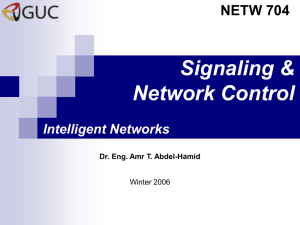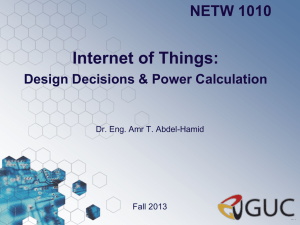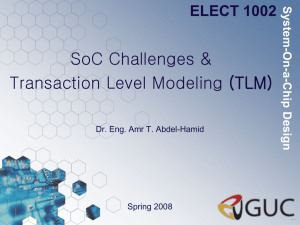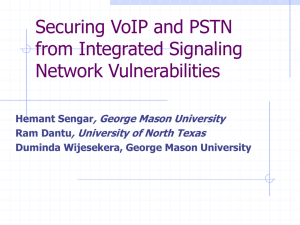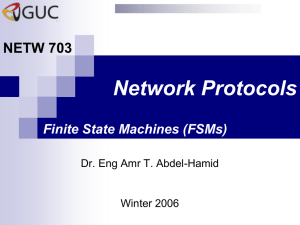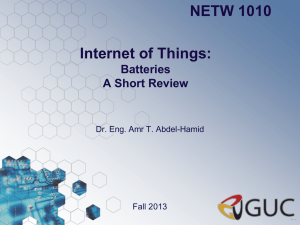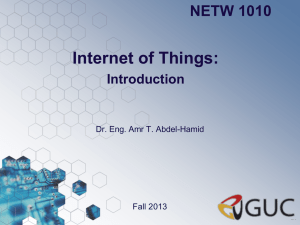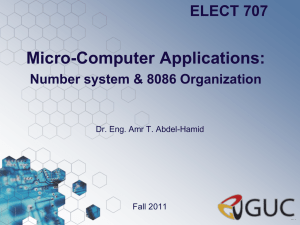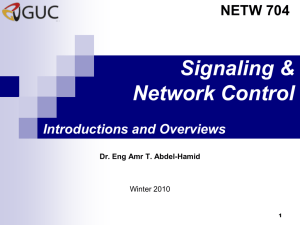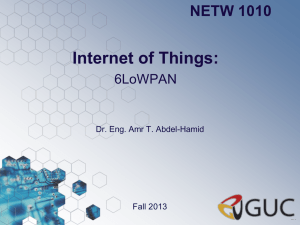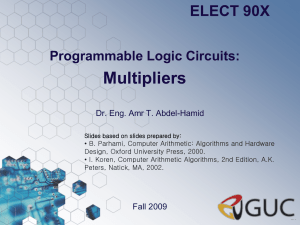Signaling and Network Control
advertisement
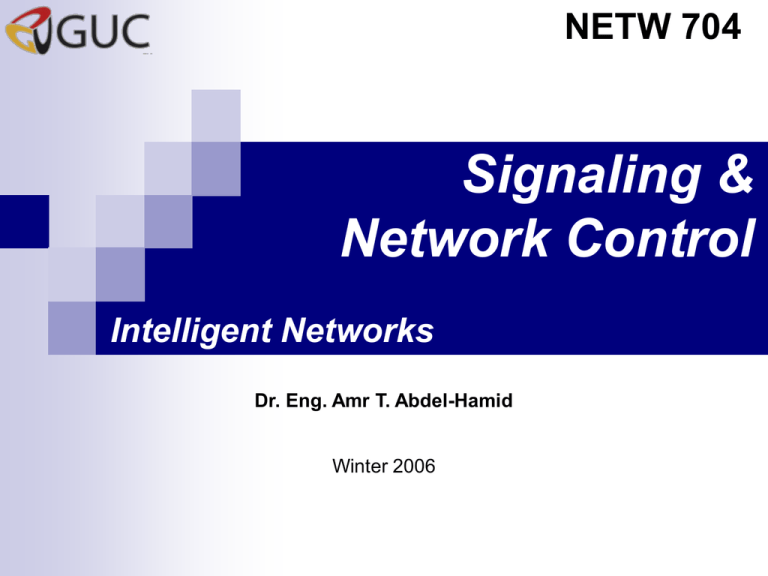
NETW 704 Signaling & Network Control Intelligent Networks Dr. Eng. Amr T. Abdel-Hamid Winter 2006 Amr Talaat, 2006 SS7 in the Converged World The "Converged World" of Next Generation Networks (NGNs) brings with it the promise of voice, video, and data over a single broadband network. This transition from the traditional circuit-switched networks to packet-switched networks has been underway for many years, and Voice over IP (VoIP) is now leading the transition. The immediate benefits of NGNs are decreased cost of infrastructure and improved ease of management. Longer-term benefits include the ability to rapidly deploy new services. Switched Circuit Network (SCN) Amr Talaat, 2006 NGN Architecture Media Gateway (MG) handles the media, or bearer, interface. It converts media from the format used in one network to the format required in another network. For example, it can terminate the TDM trunks from the PSTN, packetize and optionally compress the audio signals, and then deliver the packets to the IP network using the Real Time Protocol (RTP). Media Gateway controller (MGC) (also known as a Call Agent) contains the call processing. In addition, it manages the resources of the MGs that it controls. Signaling Gateway (SG) sits at the edge of an IP network and terminates circuit-switched network signaling, such as SS7 or ISDN, from the circuit-switched network. It transports, or backhauls, this signaling to the MGC or other IP-based application endpoint. Amr Talaat, 2006 NGN Architecture Amr Talaat, 2006 Signaling Transport (SigTran) protocol Signaling Transport (SigTran) protocol defined by RFC 2719 in the 90’s The protocol framework identified three necessary components for the SigTran protocol stack: A set of adaptation layers that support the primitives of telephony signaling protocols A common signaling transport protocol that meets the requirements of transporting telephony signaling IP network protocol Amr Talaat, 2006 SCTP The Working Group began evaluating the two commonly used transport protocols, User Datagram Protocol (UDP) and Transport Control Protocol (TCP) against these requirements. UDP was quickly ruled out because it did not meet the basic requirements for reliable, in-order transport. TCP met the basic requirements, it was found to have several limitations, such as: Head-of-line blocking: Because TCP delivery is strictly sequential, a single packet loss can cause subsequent packets to also be delayed. The analysis showed that a 1% packet loss would cause 9% of the packets being delayed greater than the one-way delay time. Timer granularity: The retransmission timer is often large (typically one second) and is not tunable. Amr Talaat, 2006 SCTP TCP further limitations: Also, because of a timer granularity issue and the lack of a built-in heartbeat mechanism, it takes a long time to detect failure (such as a network failure) in a TCP connection. A new transport protocol, Stream Control Transmission Protocol (SCTP) was developed for transporting SCN signaling. Note that SCTP is a generic transport that can be used for other applications equally well. Amr Talaat, 2006 SCTP RFC 3309 is the most updated version that describes this protocol. SCTP provides the following features: Acknowledged error-free, nonduplicated transfer of user data Data segmentation to conform to path MTU size (dynamically assigned) Ordered (sequential) delivery of user messages on a per "stream" basis Option for unordered delivery of user messages Network-level fault tolerance through the support of multihoming Explicit indications of application protocol in the user message Congestion avoidance behavior, similar to TCP Bundling and fragmenting of user data Protection against blind denial of service and blind masquerade attacks Graceful termination of association Heartbeat mechanism, which provides continuous monitoring of reachability Amr Talaat, 2006 SCTP SCTP is a connection-oriented protocol. Each end of the connection is a SCTP endpoint. An endpoint is defined by the SCTP transport address, which consists of one or more IP addresses and an SCTP port. The two endpoints pass state information in an initialization procedure to create an SCTP association. Amr Talaat, 2006 SCTP SCTP uses streams as a means of decreasing the impact of headof-line blocking. Streams provide the ability to send separate sequences of ordered messages that are independent of one another. Amr Talaat, 2006 SCTP SCTP provides the ability to have multiple streams within an association. Each stream provides reliable delivery of ordered messages that are independent of other streams. Packet 2 is dropped again. However, because packets 3, 4, and 5 belong to a different stream, they can be delivered to the application without delay. Amr Talaat, 2006 User Adaptation (UA) Layers The User Adaptation (UA) layers encapsulate different SCN signaling protocols for transport over an IP network using SCTP. UA layer is unique in terms of the encapsulation because of the differences of the signaling protocols themselves, following are some common features among all UA layers: Support for seamless operation of the UA layer peers over an IP network. Support for the primitive interface boundary of the SCN lower layer, which the UA layer replaces. For example, M2UA supports the primitive interface boundary that MTP Level 2 supports. Support for the management of SCTP associations. Support for asynchronous reporting of status changes to layer management. Amr Talaat, 2006 User Adaptation (UA) Layers MTP Level 3 User Adaptation (M3UA) layer is defined for the transport of SS7 User Part messages (such as ISUP, SCCP, and TUP). SCCP User Adaptation (SUA) layer is defined for the transport of SCCP User Part messages (such as TCAP) MTP Level 2 User Adaptation (M2UA) layer is defined for the transport of MTP Level 3 messages. MTP Level 2 Peer Adaptation (M2PA) layer is defined for the transport of MTP Level 3 data messages over SCTP. M2PA effectively replaces MTP Level 2. It provides the ability to create an IP-based SS7 link. The ISDN User Adaptation (IUA) layer is defined for the transport of Q.931 between an ISDN SG and a MGC. Amr Talaat, 2006 UA Common Terminology The UAs introduce some new terminology that did not exist in the SS7 world.: Application Server (AS): A logical entity that serves a specific Routing Key. An example of an Application Server is a virtual switch element that handles all call processing for a unique range of PSTN trunks. Another example is a virtual database element, handling all HLR transactions for a particular SS7 combination. The AS contains a set of one or more unique ASPs, of which one or more is normally actively processing traffic. Application Server Process (ASP): A process instance of an Application Server. An ASP serves as an active or backup process of an Application Server (for example, part of a distributed virtual switch or database). Amr Talaat, 2006 UA Example Amr Talaat, 2006 MTP Level 3 User Adaptation Amr Talaat, 2006 SCCP User Adaptation Amr Talaat, 2006 MTP Level 2 User Adaptation The M2UA protocol defines the layer split between MTP Level 2 and MTP Level 3. M2UA is defined by RFC 3331. Amr Talaat, 2006 MTP Level 2 Peer Adaptation

